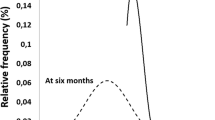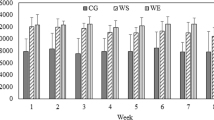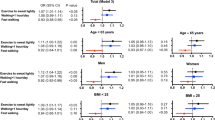Abstract
Aims
To analyze the change in risk factors for cardiovascular diseases in sedentary subjects following 1 year of guided walking and check the maintenance of the walking habit 16 months after the end of the project.
Methods
A total of 650 sedentary subjects (442 women, 208 men) were admitted to the project. Body mass index (BMI), waist circumference, systolic and diastolic blood pressure, and walking speed were determined at enrollment and redetermined after 1 year in the subjects completing the project. Daily groups of guided walking were organized.
Results
In the 326 subjects completing the project, highly significant reduction in body weight, BMI, waist circumference, systolic and diastolic blood pressure and increase in walking speed were documented. Out of the 326 finishers, 266 answered a questionnaire on the minutes of walking they were doing each week, 16 months after the end of the project: 258 declared 170 ± 110 min while eight declared to be back to inactivity.
Conclusion
Guided walking was followed by highly significant reduction in risk factors for cardiovascular diseases and improved walking speed. Seventy-seven percent of the finishers were maintaining the walking practice 16 months after the end of the project, indicating that guided walking programs can be effective in permanently modifying the lifestyle of sedentary subjects.

Similar content being viewed by others
Abbreviations
- BMI:
-
Body mass index
- WC:
-
Waist circumference
- SBP:
-
Systolic blood pressure
- DBP:
-
Diastolic blood pressure
- WS:
-
Walking speed
References
World Health Organization. Global status report on alcohol (2004) Department of Mental Health and Substance Abuse, World Health Organization, Geneva.
McPhail S, Schippers M (2012) An evolving perspective on physical activity counselling by medical professionals. BMC Fam Pract 23:13–31. https://doi.org/10.1186/1471-2296-13-31
Leitzmann MF, Park Y, Blair A, Ballard-Barbash R, Mouw T, Hollenbeck AR, Schatzkin A (2007) Physical activity recommendations and decreased risk of mortality. Arch Intern Med 167(22):2453–2460. https://doi.org/10.1001/archinte.167.22.2453
Blair SN (2009) Physical inactivity: the biggest public health problem of the 21st century. Br J Sports Med 43:1–2
Lee DC, Sui X, Artero EG, Lee IM, Church TS, McAuley PA, Stanford FC, Kohl HW 3rd, Blair SN (2011) Long-term effects of changes in cardio-respiratory fitness and body mass index on all-cause and cardiovascular disease mortality in men. Circulation 124:2483–2490. https://doi.org/10.1161/CIRCULATIONAHA.111.038422
Hamer M, Lavoie KL, Bacon SL (2014) Taking up physical activity in later life and healthy ageing: the English longitudinal study of ageing. Br J Sports Med 48(3):239–243. https://doi.org/10.1136/bjsports-2013-092993
Yates LB, Djoussé L, Kurth T, Buring JE, Gaziano JM (2008) Exceptional longevity in men. Modifiable factors associated with survival and function to age 90 years. Arch Intern Med 168(3):284–290. https://doi.org/10.1001/archinternmed.2007.77
Murtagh EM, Nichols L, Mohammed MA, Holder R, Nevill AM, Murphy MH (2015) The effect of walking on risk factors for cardiovascular disease: an updated systematic review and meta-analysis of randomised control trials. Prev Med 72:34–43. https://doi.org/10.1016/j.ypmed.2014.12.041
American College of Sports Medicine (2004) ACSM’s health-related physical fitness assessment manual. Lippincott, Williams and Wilkins, Philadelphia
Morice A, Smithies T (1984) The 100 m walk: a simple and reproducible exercise test. Br J Dis Chest 78(4):392–394
Rana BSJB (2016) Reliability and reproducibility of Physiological Cost Index (PCI) as an Energy Expenditure Index among Asian individuals. J Inst Med 38(1):66–69
Borg GA (1982) Psychophysical bases of perceived exertion. Med Sci Sports Exerc 14(5):377–381
Chiaranda G, Myers J, Mazzoni G, Terranova F, Bernardi E, Grossi G, Codecà L, Conconi F, Grazzi G (2012) Peak oxygen uptake prediction from a moderate, perceptually regulated, 1-km treadmill walk in male cardiac patients. J Cardiopulm Rehabil Prev 32:262–269. https://doi.org/10.1097/HCR.0b013e3182663507
Grazzi G, Chiaranda G, Myers J, Pasanisi G, Lordi R, Conconi F, Mazzoni G (2017) Outdoor reproducibility of a 1-km treadmill-walking test to predict peak oxygen consumption in cardiac outpatients. J Cardiopulm Rehabil Prev 37(5):347–349. https://doi.org/10.1097/HCR.0000000000000266
Foglietta F, Buriani O, Casaroli C, De Togni A, Pasetti P, Conconi F (2013) From research to medical advice: prescription of physical activity to 1,005 subjects with type 2 diabetes mellitus by 48 family doctors. Results. Epidemiol Prev 37(2–3):132–137
Grazzi G, Mazzoni G, Myers J, Codecà L, Pasanisi G, Napoli N, Guerzoni F, Volpato S, Conconi F, Chiaranda G (2016) Improved walking speed is associated with lower hospitalisation rates in patients in an exercise-based secondary prevention programme. Heart 102(23):1902–1908. https://doi.org/10.1136/heartjnl-2015-309126
Chiaranda G, Bernardi E, Codecà L, Conconi F, Myers J, Terranova F, Volpato S, Mazzoni G, Grazzi G (2013) Treadmill walking speed and survival prediction in men with cardiovascular disease: a 10-year follow-up study. BMJ Open 3(10):e003446. https://doi.org/10.1136/bmjopen-2013-003446
USDHHS (2008) Physical activity guidelines for Americans. Washington, DC. www.health.gov/paguidelines/
Gillam I (2015) Success story: how exercise physiologists improve the health of Australians. Br J Sports Med 49(16):1028. https://doi.org/10.1136/bjsports-2015-094687
Maiorana A, Levinger I, Davison K, Smart N, Coombes J (2016) Exercise prescription is not just for medical doctors: the benefits of shared care by physicians and exercise professionals. Br J Sports Med Publ Online First 0:1–2. https://doi.org/10.1136/bjsports-2016-096994
Stanaway FF, Gnjidic D, Blyth FM, Le Couteur DG, Naganathan V, Waite L, Seibel MJ, Handelsman DJ, Sambrook PN, Cumming RG (2011) How fast does the Grim Reaper walk? Receiver operating characteristics curve analysis in healthy men aged 70 and over. BMJ 15(343):d7679. https://doi.org/10.1136/bmj.d7679
Studenski S, Perera S, Patel K, Rosano C, Faulkner K, Inzitari M, Brach J, Chandler J, Cawthon P, Connor EB, Nevitt M, Visser M, Kritchevsky S, Badinelli S, Harris T, Newman AB, Cauley J, Ferrucci L, Guralnik J (2011) Gait speed and survival in older adults. JAMA 305(1):50–58. https://doi.org/10.1001/jama.2010.1923
Arem H, Moore SC, Patel A, Hartge P, Berrington de Gonzalez A, Visvanathan K, Campbell PT, Freedman M, Weiderpass E, Adami HO, Linet MS, Lee IM, Matthews CE (2015) Leisure time physical activity and mortality: a detailed pooled analysis of the dose-response relationship. JAMA Intern Med 175(6):959–967. https://doi.org/10.1001/jamainternmed.2015.0533
Cherkas LF, Hunkin JL, Kato BS, Richards JB, Gardner JP, Surdulescu GL, Kimura M, Lu X, Spector TD, Aviv A (2008) The association between physical activity in leisure time and leukocyte telomere length. Arch Intern Med 168(2):154–158. https://doi.org/10.1001/archinternmed.2007.39
Author information
Authors and Affiliations
Contributions
All authors contributed to the writing of this manuscript and approved the final submitted version. SM and FC involved in data acquisition, data analysis, and interpretation.
Corresponding author
Ethics declarations
Funding
The study was supported by the Italian Ministry of Education and Scientific Research and the Ministry of Sport.
Availability of data and materials
Data and materials can be requested from the corresponding author.
Conflict of interest
The authors declare that they have no competing interests.
Consent for publication
Not applicable.
Ethics approval and consent to participate
The Ethics Committee of the Ferrara University Hospital approved all study procedures and participants provided written informed consent to participate in the study.
Informed consent
Informed consent was obtained from all participants included in the study.
Rights and permissions
About this article
Cite this article
Mandini, S., Collini, G., Grazzi, G. et al. Reduction in risk factors for cardiovascular diseases and long-lasting walking habit in sedentary male and female subjects following 1 year of guided walking. Sport Sci Health 14, 121–126 (2018). https://doi.org/10.1007/s11332-017-0412-3
Received:
Accepted:
Published:
Issue Date:
DOI: https://doi.org/10.1007/s11332-017-0412-3




